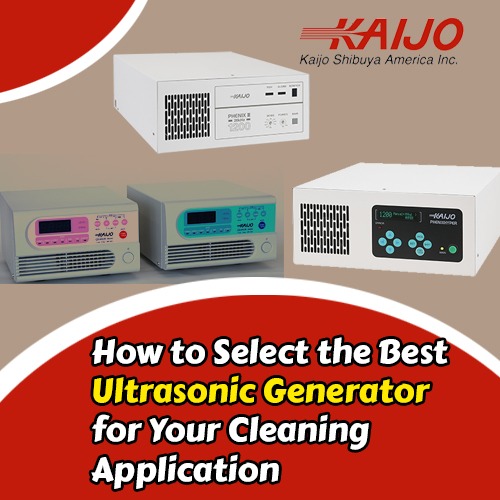Selecting an Ultrasonic Generator for Your Cleaning Application
February 13, 2019

While ultrasonic cleaning systems include generators, transducers and a cleaning tank, it is the ultrasonic generator that determines the main characteristics of the system. Therefore, choosing the properultrasonic generator is important for obtaining the specified performance. The generator has to have the right operating specifications and capabilities required for the cleaning application. The transducers and tank size have to match the generator as well. If the right generator is not used, the ultrasonic cleaning system may work more slowly than expected or may not clean completely.
Power and Frequency
The power of the generator is determined by the size of the parts to be cleaned. The parts have to fit into the cleaning tank and be submerged in the cleaning solution. For smaller parts, a basket to hold them off the tank bottom and away from the sides may be needed. The tank size has to be large enough so the largest parts or the basket will fit. The tank size, in turn, determines how much power is required to fill the tank evenly with ultrasonic waves.
The generator frequency determines the intensity of the ultrasonic cleaning action. Low frequencies create comparatively large cavitation bubbles that deliver robust scrubbing and cleaning. High frequencies create smaller bubbles that clean gently. Depending on the cleaning application, the generator should be able to produce the corresponding frequency, multiple frequencies or a frequency range.
Kaijo’s Quava high power ultrasonic generator delivers up to 1200 W power and is configurable to ten frequencies ranging from 26 kHz to 950 kHz. The generator is ideal cleaning applications ranging from metal engine parts encrusted with oil, grease and deposits to delicate circuit boards or optical components. The Quava Ultrasonic Generator tracks frequencies automatically and no field calibration is required.
Control, Operation and Performance
An ultrasonic cleaning system is controlled from the ultrasonic generator. If remote operation is required, the generator has to be able to communicate with a remote control system. The controls may also vary the operating frequency slightly in a “sweep mode.” Normally, the generator controls operate the generator at exactly the selected frequency. In some applications, this mode of operation results in uneven distribution of the ultrasonic waves in the cleaning tank. Such “hot” and “dead” spots can be caused by standing waves due to the tank and transducer configuration or by patterns induced from the shape of the parts to be cleaned. Continuously varying the frequency above and below the operating frequency by 2 to 3 kHz often breaks up such standing waves and patterns, resulting in a more even distribution of the sound waves and the resulting cavitation bubbles.
The Phenix Hyper Ultrasonic Generator can operate in standard sweep mode or in a special hyper mode to improve cleaning performance. Hyper mode allows the generator to fill the cleaning tank evenly with ultrasonic energy and clean all kinds of parts, even those with complex shapes, quickly and completely. This ultrasonic cleaning generator operates at 78 kHz with 1200 Watts of power and has an auto tuning function that keeps the frequency adjusted when operating conditions change.
Kaijo Can Help Select the Best Generator
With over 60 years of experience in the field of ultrasonic technology, Kaijo has the expertise to help their customers select ultrasonic system components such as the generator and ensure that the cleaning system meets their needs. The company can evaluate the proposed cleaning application, determine the required characteristics of the ultrasonic system components, and recommend products from their own complete line of ultrasonic generators, transducers and cleaning tanks.





